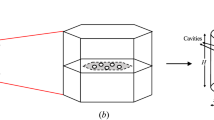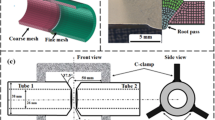Abstract
The fatigue failure around fastener holes in metal structures is particularly dangerous, since it leads to inevitable accidents. The presence of residual compressive hoop stresses around these holes, imparted by means of mandrel cold working methods closes the existing cracks and impedes the formation of new ones and thereby extends the fatigue life of corresponding component. Although this type of pre-stressing of fastener holes has been of great advantage over recent years it has some disadvantages: significant and nonsymmetrical with respect to the plate middle plane axial gradient of the residual hoop stresses due to axial force flow passing through the plate, considerable surface upset, etc. The article presents a patented method and a tool ensuring symmetric cold hole expansion—introducing near-uniform residual hoop stresses around the hole along its axis having minimized and symmetric gradient with respect to the plate middle plane. Finite element (FE) simulations of the new process have been carried out. The residual stresses and out-of-plane deformations (surface upset) have been analyzed and compared with those obtained by mandrel cold working method and thus the advantages of the patented method have been shown. The symmetric cold expansion process has been realized experimentally and modeling of residual stress distribution around cold expanded holes in carbon steel specimens has been made. The residual hoop stresses have been measured by means of X-ray diffraction technique. The obtained generalized empirical mathematical model of the residual hoop stress distribution is polynomial with respect to the distance from the hole edge and has “coefficients” that are functions of the governing factors. On the basis of the information obtained from FE simulations, suitable fractional factorial experimental design has been synthesized and used for obtaining the polynomial “coefficients”. The verifications of the generalized model prove its authenticity.















Similar content being viewed by others
References
Focke AE, Mize GG (1947) Chain. USA Patent 2,424,087, 15 July 1947
Champoux LA (1971) Coldworking method and apparatus. USA Patent 3,566,662, 2 Mar 1971
Hogenhout F (1987) Method and apparatus for hole coldworking. USA Patent 4,665,732, 19 May 1987
Reid L (1993) Beneficial residual stresses at bolt holes by cold expansion. In: Kalker JJ et al (eds) Proceedings of “rail quality and maintenance for modern railway operation”. Kluwer Academic Publishers, Netherlands, pp 337–347
Kang J et al (2002) Three dimensional finite element analysis of the cold expansion of fastener holes in two aluminum alloys. J Eng Mater Technol 124:140–145
Kim C et al (2004) Finite element analysis of the residual stress by cold expansion method under the influence of adjacent holes. J Mater Process Technol 153–154:986–991
Babu NCM et al (2008) A simplified 3-D finite element simulation of cold expansion of a circular hole to capture through thickness variation of residual stresses. Eng Fail Anal 15(4):339–348
De Matos PFP (2005) Numerical simulation of cold working of rivet holes. Finite Elem Anal Des 41(9–10):989–1007
Maximov JT, Duncheva GV (2008) A new 3D finite element model of the spherical mandrelling process. Finite Elem Anal Des 44(6–7):372–382
Maximov JT et al (2013) A novel method and tool which enhance the fatigue life of structural components with fastener holes. Eng Fail Anal 31:132–143
Ganev N, Kraus I (2000) Engineering applications of X-ray stress analysis. advances in X-ray analysis. In: Proceedings of the 49th annual conference on applications of X-ray analysis (Denver X-ray conference), 31.07–04.08 2000, Denver, vol 44. pp 174–186
Maximov JT, Duncheva GV (2010) Coldworking tool for fastener holes. BG Patent 66,052 B1, 30 Dec 2010
Acknowledgments
This work is a part from Project No SIP-02-27/18.05.2009 “A Novel Method for Enhancement of Fatigue Life and Load-Carrying Capacity of Structural Components with Fastener Holes”. The project is implemented with the financial support of European Union and Republic of Bulgaria, European Regional Development Fund, Operational Programme: “Development of the Competitiveness of the Bulgarian Economy 2007–2013”, Measure: 1.1.1.: “Support for the Creation and Development of Innovative Start up Companies” 2007 BG 1610003/1.1.1-01/2007.
Author information
Authors and Affiliations
Corresponding author
Additional information
Technical Editor: Alexandre Mendes Abrao.
Rights and permissions
About this article
Cite this article
Maximov, J.T., Duncheva, G.V., Ganev, N. et al. Modeling of residual stress distribution around fastener holes in thin plates after symmetric cold expansion. J Braz. Soc. Mech. Sci. Eng. 36, 355–369 (2014). https://doi.org/10.1007/s40430-013-0090-2
Received:
Accepted:
Published:
Issue Date:
DOI: https://doi.org/10.1007/s40430-013-0090-2




